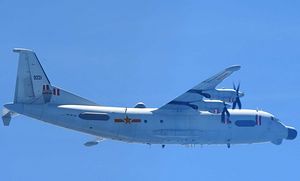Following a six-week hiatus, Japan’s Ministry of Defense (MoD) has for the first time revealed the interception of a foreign military aircraft by the Japan Air Self Defense Force (JASDF). The service scrambled fighter jets to intercept a People’s Liberation Army Navy Air Force (PLANAF) Shaanxi Y-9JB (GX-8) electronic warfare and surveillance plane in the East China Sea crossing the Miyako Strait on June 16, the MoD said in a recent statement.
Japanese airspace was not violated, according to the MoD.
The aircraft was escorted flying through international airspace between the Japanese islands of Okinawa and Miyako. Intercepts of People’s Liberation Army Air Force (PLAAF) and PLANAF aircraft principally take place in airspace close to Okinawa and Miyako in the East China Sea. The Miyako Strait is one of the principal entryway for Chinese air forces and the People’s Liberation Army Navy (PLAN) into the Pacific Ocean and regularly holds long-range exercises in its vicinity and surrounding area.
The last reported intercept of two Y-9JB (GX-8) electronic warfare and surveillance aircraft flying over the East China Sea took place in April. The PLAAF and PLANAF usually rely on Y-9JBs, an upgraded variant of China’s first-generation Y-8DZ and Y-8G electronic reconnaissance aircraft, to conduct surveillance missions in close proximity to Japanese islands and airspace. As I noted elsewhere, the Y-9JB was retrofitted a couple of years back:
In 2015, the Y-9JB was reportedly upgraded with a 5,000-horsepower 6C turboprop engine with six-blade composite propellers to enhance its range and endurance. Additionally, the aircraft was retrofitted with improved cabin pressurization for missions in higher altitudes. It purportedly has also been equipped with upgraded electronic systems, including new fairings and antennas.
Given the PLANAF aircraft’s pennant number, the plane that was tracked by Japanese aircraft on June 16 most likely belongs to the 4th Air Regiment of the 2nd PLANAF “specialized” Division based at Laiyang in Shangdong Province. The division is part of the PLAN’s North Sea Fleet. It main missions are anti-submarine warfare, electronic signals intelligence, and electronic warfare operations.
Japan’s MoD usually publishes scrambles against Y-9JB aerial patrols at an approximate four-week interval. It is unclear whether the recent reporting break has been due to a reduction in PLANAF/PLAAF activity, or whether the MoD is more selectively making these intercepts public.
The JASDF scrambled its fighter jets 999 times against foreign military aircraft in fiscal year 2018. In 2018, 64 percent of the total, or 638 scrambles were against PLAAF/PLANAF aircraft, up from 500 in 2017.
“The JASDF is confronted by a pending shortage of fighter aircraft as the service has doubled the number of fighters dispatched for each intercept of foreign military planes from two to four in 2016,” I wrote in May. “The JASDF uses Mitsubishi F-15J/Kai all-weather air superiority fighters, F-2 multirole fighter jets, a Mitsubishi license-produced variant of Lockheed Martin’s F-16, and F-4EJ/RF-4 Phantom II fighter aircraft to conduct scrambles.”
Earlier this month, the PLAN aircraft carrier Liaoning was also spotted by the JASDF and Japan Maritime Self Defense Force (JMSDF) transiting the Miyako Strait from the East China Sea into the Pacific.

































